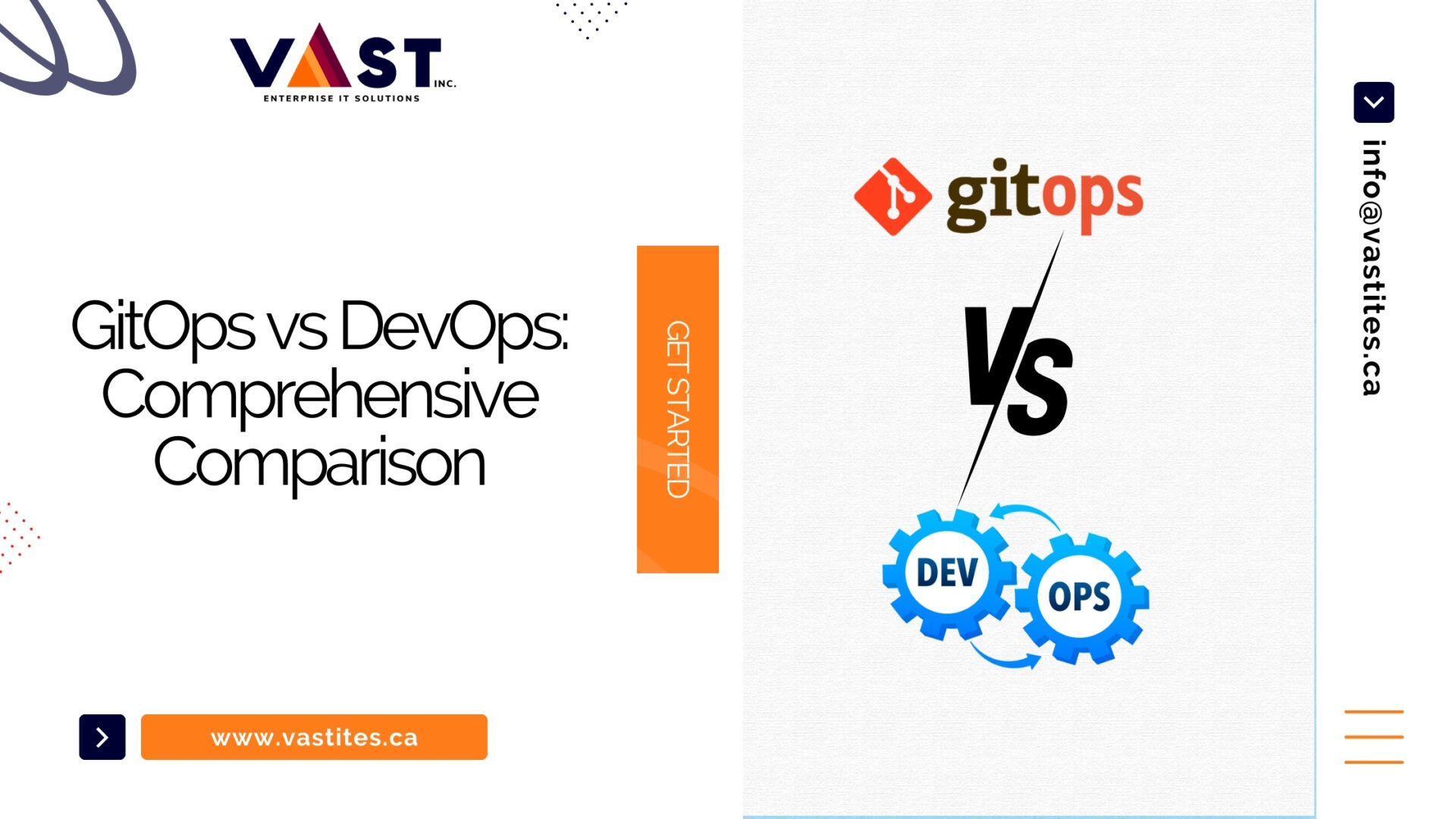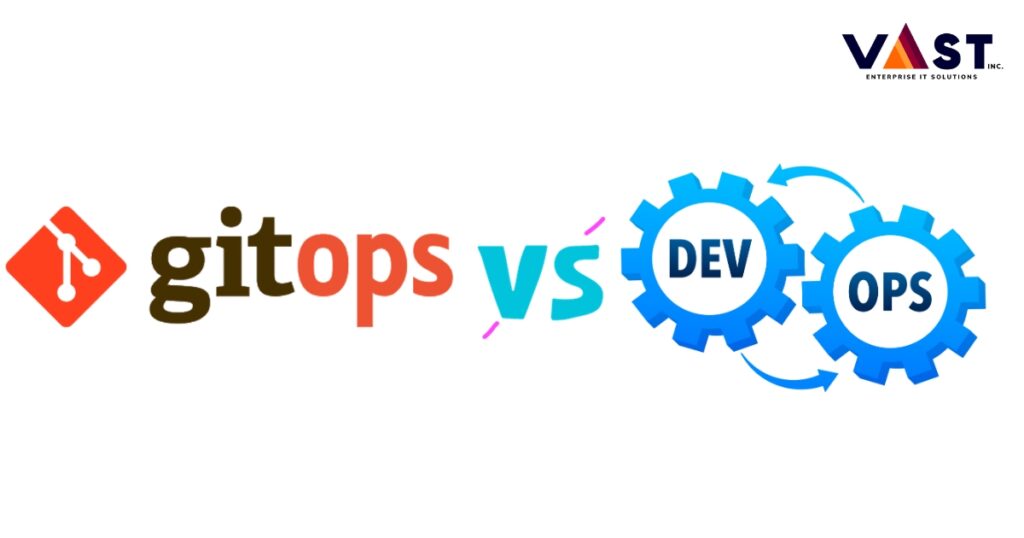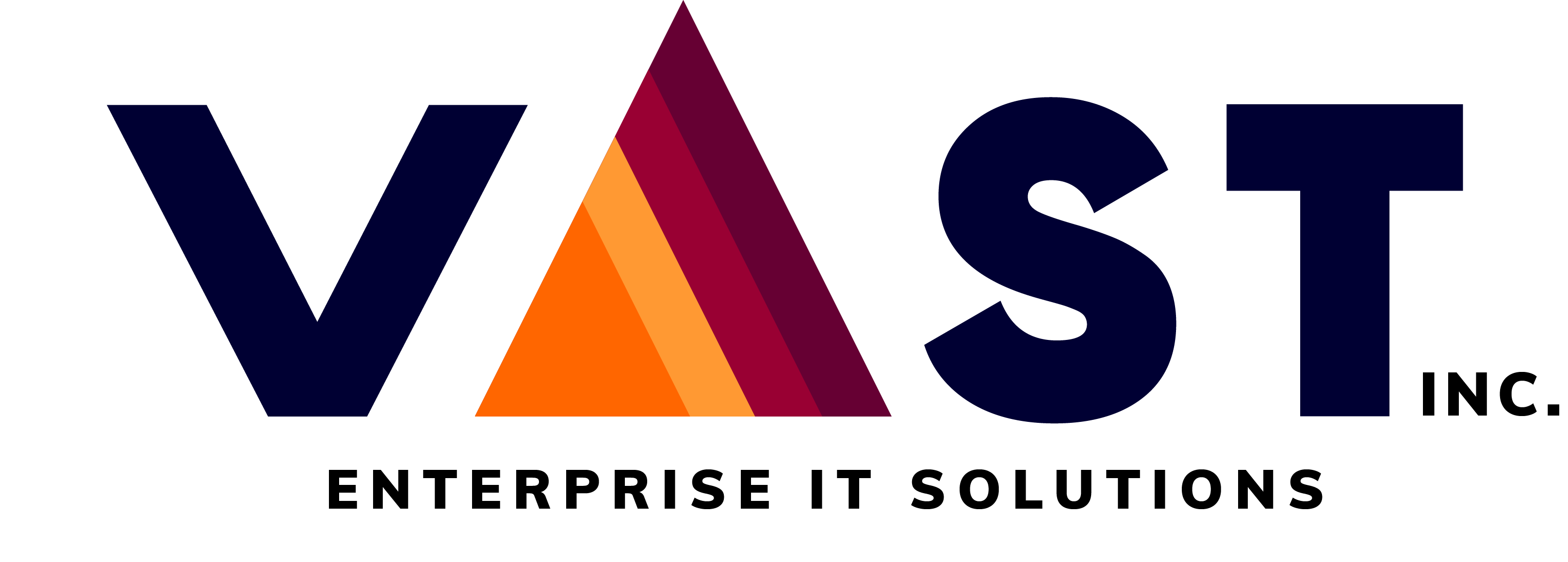
Introduction
In today’s rapidly evolving technological landscape, understanding the differences and similarities between GitOps and DevOps has become essential for organizations making progress toward productivity and agility in software development and activities. Both GitOps and DevOps are compelling practices in the realm of cloud computing and IT practices, each offering one-of-a-kind ways to deal with overseeing and conveying programming. The purpose of this blog is to examine the fundamentals of GitOps and DevOps, highlighting their distinctive features, contrasting their strengths and weaknesses, and the scenarios in which each is most effective. This comprehensive guide will provide you with valuable insights into these two essential methodologies, allowing you to make well-informed decisions regarding your organization’s requirements.
What is DevOps
DevOps is a practice that involves the collaboration of development and Operations to streamline and deploy software in repeated cycles. This approach automates the repeated tasks. With the help of this practice, organisations can cut the time to market and deliver the applications and services in a jiff. You can build automated structures and rapid software development system with DevOps practices.
Read more: What is the best strategy for implementing DevOps?
Key Features of DevOps
- This model is considered as a working culture
- DevOps supports various CI/CD tools and is not restricted to any one technology
- DevOps decreases human input, thus increasing automation and regular deployment.
- You can use cloud configuration for coding, supply change management and other necessary requirements.
- The DevOps channel separates development and operations processes and improves the communication between them
How does DevOps work
DevOps integrates the development, testing, and deployment phases of the software development life cycle into a smooth, consistent process. In order to implement this, you need to utilize the best DevOps tools. These tools streamline the IT processes and make your work easier.
Read more: 4 Best tools to learn DevOps – How to start DevOps?
To accomplish this, you ought to automate several processes by utilizing tools, for example, version control systems, automated testing structures, and CI/CD deployment pipelines.
DevOps lifecycle goes through different lifecycle phases before delivering the end product. The different phases in DevOps lifecycle are:
- Plan: the first and foremost step is to plan. Development teams define the requirements and the goals for the project. Then it lays the plan for executing the project
- Code: The development team utilizes version control tools such as Git, Subversion and Mercurial to collaborate on the code.
- Build: The development team builds the code in such a way that it is compiled and made executable.
- Test: The code is tested to check for bugs and errors and to guarantee that it works as expected.
- Deploy: Software features are delivered regularly into production utilizing a CD pipeline.
- Operations: This is where the operations enter the picture. They approve the product’s suitability for clients in a production environment.
- Observation and Monitoring: Development and operations teams get consistent monitoring and input, allowing them to quickly identify and determine issues.
Benefits of DevOps
DevOps is the need of the hour. Most of organizations are now adopting DevOps practices in their day-to-day IT processes. Here are some of the benefits of DevOps:
- Automating the repetitive tasks
- Decreasing the time to market
- Better communication between development and operations teams
- Increased efficiency
- Improving product quality
- Increased productivity
- Improvement in the operational support system
- Improved customer experience
- More time for priority tasks
- Decreased risks of failure
Challenges of implementing DevOps strategies
DevOps is still a new technology in the market. Developers still face various issues while implementing DevOps strategies. Here are some common challenges that organizations face while adopting DevOps practices:
- Lack of skillset of developers
- Need of positive mindset in the organization
- Open to changes and adaptions
- Challenges in legacy systems
- CI/CD security measures
- Lack of expertise in this domain
- Choosing the right tools and technology for your organization
- Challenges in transitioning to workflows
While these challenges might sound easy to deal with. But it might create big problems when not done correctly. It is best to seek experts when implementing DevOps in an organization. VaST ITES Inc is the best DevOps consulting in Toronto. They have been in the market for a long and are aware about the DevOps process and tackle the challenges easily.
Also read: Challenges of DevOps Implementation – how to solve them
Integrate DevOps strategy
Implementing a DevOps strategy in the workflows of your organization is not a very tricky task. Here are the steps to implement the DevOps strategy in your workflows:
- Build a continuous integration/continuous delivery (CI/CD) pipeline
- By configurating this new pipeline the new pipeline, you will enable automated deployment of changes to your development environment
- Create a monitoring alerting system in your development workflows
- Create channels where both the teams, development and operations teams can communicate. In this way operational teams will be able to inform the development teams about the new opportunities to improve the workflow of business.
What is GitOps
Developers use GitOps to store everything connected with a project’s infrastructure in Git repositories, including code, setup, and application records. They use the Git repository as a single source of truth (SSOT) for both the application code and Infrastructure as Code (IaC). It focuses on deploying IaC and applying DevOps practices, for example, pull requests, branching, merging, code reviews, and testing to infrastructure automation. The single source of truth in GitOps is Git, and that implies just changes in Git can trigger builds and deployment in infrastructure and applications. GitOps is frequently utilized by associations that utilize Kubernetes for container orchestration.
Key Features of GitOps
- It is completely dependent on Git version control
- Git is used as the single source of truth for every change in the codebase
- You can use Kubernetes and IaC practices and other CI/CD pipelines with the help of GitOps
- GitOps smooths the transition between development and operations workflows
- It increases the development times and reduces the dependability of lengthy scripts.
How does GitOps work?
GitOps intends to treat IaC the same way as application code. This implies you store infrastructure configurations in Git repositories and version and manage configurations involving similar tools and processes as application code. This guarantees you can appropriately test and review changes made before deployment.
In GitOps workflows, there’s a Git repository for the IaC project and a DevOps pipeline for it. This is what an essential GitOps workflow looks like:
- Make a Git repository to act as an SSOT and to hold both the IaC and application code.
- Make pull/merge requests to make changes and team up before pushing back to the principal branch of the repository.
- Run a CI pipeline to incorporate changes, approve configuration files, and perform automated tests.
- Review and approve the changes to guarantee that the changes are very much tested before being applied in an environment.
- Run a CD pipeline for the continuous deployment of the infrastructure.
Benefits of GitOps
GitOps is the newer technology. It brings in many advantages that is beneficial for organizations. Some of the benefits of GitOps is:
- Improved access control
- Reduced risks
- Better collaboration of infrastructure changes
- Less errors
- Transparency
- Easy environment duplication
Challenges of GitOps
Since GitOps is a new technology. It comes with lot of challenges. Here are some of the common challenges of GitOps:
- Cannot fix faulty practices
- No programming updates
- Challenging to audit
- Huge number of repositories
- Doesn’t help with secret management
- Difficult to make changes
Integrate GitOps Strategy
Integrating GitOps strategy in business workflows is quite simple. Following are the steps to integrate the GitOps strategy:
- Build a Git repository for your codebase. For this you don’t need to specially use GitHub. Any code repository using Git can do this.
- Connect CI/CD tool to the repository
- By configuring CI/CD, you will be able to deploy automatic changes to your development environment. You may use tools like Jenkins or Circle CI.
Read more: Jenkins vs. Other CI/CD Tools: Making the Right Choice for your Project
4. Create a monitoring alerting system in your development workflows
GitOps vs DevOps: Difference between them

We have discussed above the basic functioning of both DevOps and GitOps. We can clearly see that both of them have somewhat similar functioning. Once you understand their key differences, it will be easier for you to make the decision about which option is better. Here are the key differences between GitOps and DevOps:
- DevOps is a methodology for bringing together operations and development teams to collaborate and communicate more effectively. This assists with shortening the feedback time between the two groups and speeds up the development processes. GitOps is the execution of DevOps best practices that emphasize utilizing Git to manage infrastructure and application deployment.
- GitOps involves Git as the SSOT for overseeing infrastructure and application deployment and other related tools like Kubernetes, IaC, and different CI/CD pipelines. DevOps, then again, utilizes a more extensive assortment of tools to automate the whole SDLC. These tools incorporate version control tools like Git, CI/CD tools, for example, Jenkins and Ansible, containerization tools like Docker and Kubernetes, and Iac devices like Terraform.
- GitOps focuses on handling IaC properly by implementing the best DevOps strategies. GitOps focuses on IaC appropriately utilizing the best DevOps rehearses. DevOps focuses on the automation of the software development process from beginning to end. Testing, continuous deployment, observation, and monitoring are all examples of this.
- The fundamental objective of GitOps is correctness by guaranteeing that all changes of infrastructure and application code are made through pull demands that are inspected and tried before being conveyed. This assists with keeping mistakes and irregularities from being brought into the production environment. The primary objective of DevOps is to work on the speed, proficiency, and nature of software development and delivery by breaking down silos between improvement, activities, and different groups engaged with the product development life cycle.
GitOps vs DevOps: Similarities between them
GitOps and DevOps are two very similar approaches. Let’s look at the similarities between them
- Both GitOps and DevOps approaches focus on improving the efficiency of the software development processes. This means integrating from the start to the end of the process.
- The end goal of DevOps is to decrease the software development cycle by automating the tasks and encouraging collaboration between the teams.
- The end goal of GitOps is quite similar, but it follows a slightly bit different approach. Instead of focusing on collaboration between teams, it focuses on code repositories like GitHub as a single source of truth (SSOT).
- Both approaches automate tasks for increase efficiency. This allows developers to focus on more important tasks. It also helps to reduce manual errors.
They help to decrease errors and increase transparency. This helps to avoid unexpected issues that might come in future.
GitOps vs DevOps: Making the right choice for your organization
GitOps and DevOps are two different technologies. Choosing which approach majorly depends on the needs of the organization. Both of them come with their unique benefits and challenges. Being aware of when to adopt the right approach also determines the efficiency and productivity of the organization.
When you need a fast and reliable deployment process, you may choose GitOps practices for your organizations. It is also best suitable for organizations that seek more secure workflows and require disaster recovery capabilities. With GitOps, you can allow only a specific group of people to review and approve changes before deployment.
If you are a large-scale organization with multiple teams and departments, then DevOps is the better choice for you. The DevOps approach emphasises collaboration between development and operations teams to improve communication. You can also customize your deployment processes by using various tools. Also DevOps, comparatively, is an older technology. Which means you can find better support and resources.
You can also get the best of both worlds. You can integrate both GitOps and DevOps in your practices.
How does DevOps work with GitOps
- Developer commits code to repo
- CI server builds the new version of the code and makes the image
- CI server pushes the image to a repo
- A GitOps agent deployed in the cluster recognizes the change and automatically rolls out the vital improvements in the cluster. There is no immediate association between the CI system and the Kubernetes cluster.
Now if there is any change to be made in the container due to any reason like the discovery of a bug or low performance. GitOps makes it possible to go back to the last good configuration in the git repository. Git then becomes the single source of truth. Additionally, the security permission for CI permission separates from the security permission for CD systems.
Future of DevOps
Many developers are worried that GitOps is replacing DevOps. Well, that’s not the case. GitOps would not necessarily replace DevOps. As we discussed earlier, even though GitOps and DevOps are somewhat similar. But their workings and technologies are very different. We can say that GitOps is part of DevOps. This is because GitOps is an approach to implementing DevOps best practices. So if we look at the closer picture, GitOps, in a way, is just improving the DevOps processes. It is true that with its features like better collaboration, security, precision, etc. GitOps is gaining popularity in the market. DevOps can never be replaced as it is deeply rooted and adopted by many organizations. Additionally, DevOps supports many technologies and tools to serve a variety of choices of organizations. But GitOps only supports a specific technology and is a recent technology that only a few people know of.
Conclusion
All in all, GitOps and DevOps address two crucial techniques in the domain of software development and IT activities, each with its exceptional assets and applications. While GitOps offers accuracy and control through its emphasis on Git as a solitary wellspring of truth, DevOps centers around the more extensive joining of improvement and tasks to upgrade coordinated effort and effectiveness. It is essential to comprehend their differences and similarities before selecting the appropriate strategy for your organization. Recognizing that these methods are not mutually exclusive but can be combined to achieve the best of both worlds is essential as technology continues to advance. The eventual fate of software development is probably going to see further developments and emphases of these systems, accentuating the significance of flexibility and constant learning in the consistently changing scene of IT.
